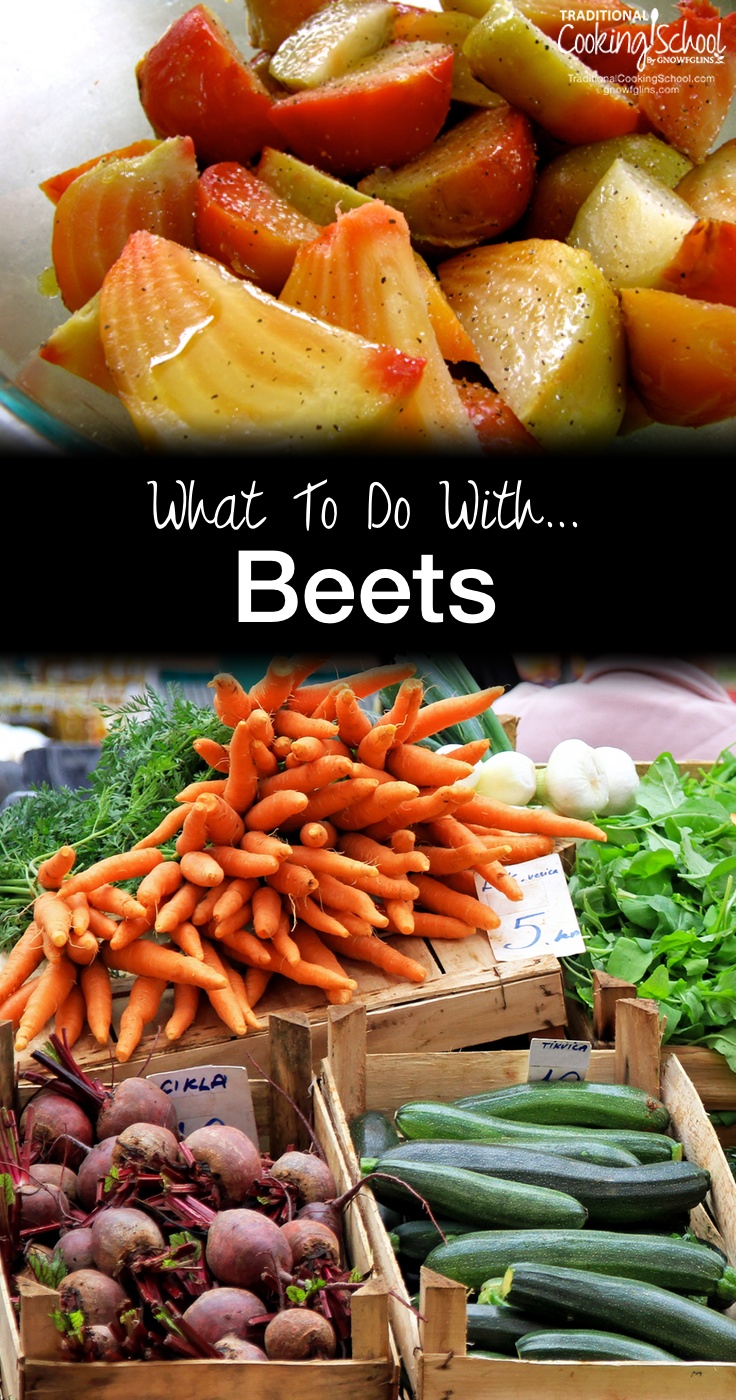
Beets!
When blessed with a harvest of beets (as we were last weekend), you can’t help but say to yourself, “Now what am I going to do with all of these?”
And of course *some* little people may be thinking, “Oh, NO, it’s time for beets again.”
With a household of reluctant beet-eaters, how do I obtain familial happiness in beet season? I prepare them multiple ways!
This makes full use of the harvest, and provides lots of beet nutrition to boot. Beets are shown to have antioxidant and anti-inflammatory properties, plus they’re beneficial for detoxification (source).
In this round-up of nutritious beet recipes, I will begin with a brand-new recipe for fermented beets, and then share other ideas for eating up those nutritious beets. Be sure to share your favorite ways to use beets in the comments!
Fermented Beets (Shredded)
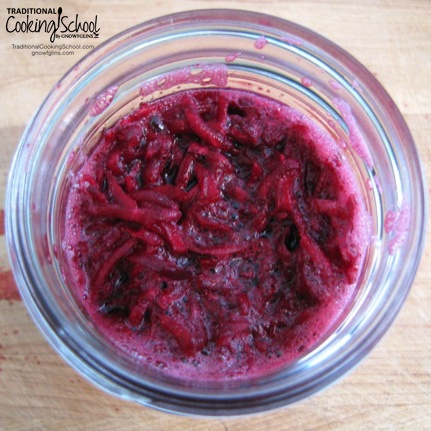
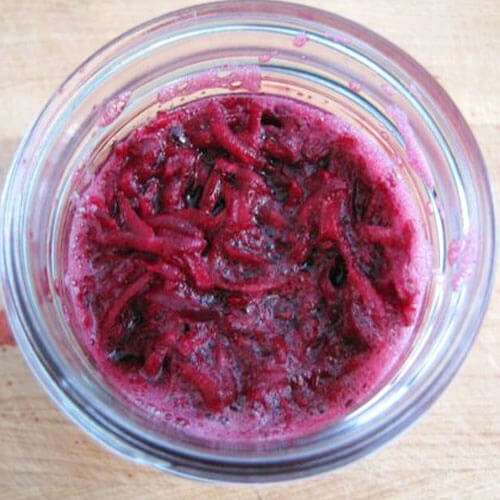
Fermented Beets (Shredded)
Yields 1 quart.
Ingredients
- 6 cups raw beets shredded, peel beets beforehand
- 3/4 to 1 tablespoon sea salt
Instructions
-
Combine beets and salt in a mixing bowl.
-
Let sit 5 minutes for the mixture to get watery.
-
Pack in a clean quart-size jar, leaving 1 inch of head space for release of juices and gases.
-
Cover tightly with lid or airlock.
-
Let ferment at room temperature for 2 days.
-
Burp jar as needed.
-
Chill.
Recipe Notes
Keeps several weeks to months in cold storage. Serve with salad or alongside eggs.
Oven-Roasted Beets

We love oven-roasted beets! They’re sweet and tender. Delicious tossed with extra virgin olive oil, sea salt, and pepper. Or drizzled with ranch dressing.
Or, I love to drizzle with plain yogurt, then sprinkle with sea salt and dried mint.
Go here to find out how to make easy oven-roasted beets (plus a free video).
Pickled Beets
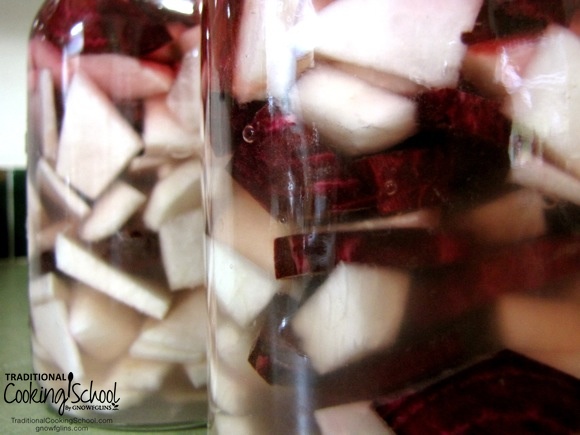
Combine peeled and sliced raw beets with other root vegetables (such as turnips, as shown). Then cover with brine and let ferment into crunchy beet pickles. They’re delicious! Here’s the recipe.
Also, Nourishing Traditions contains a recipe for pickled beets using already roasted beets.
Beet Kvass
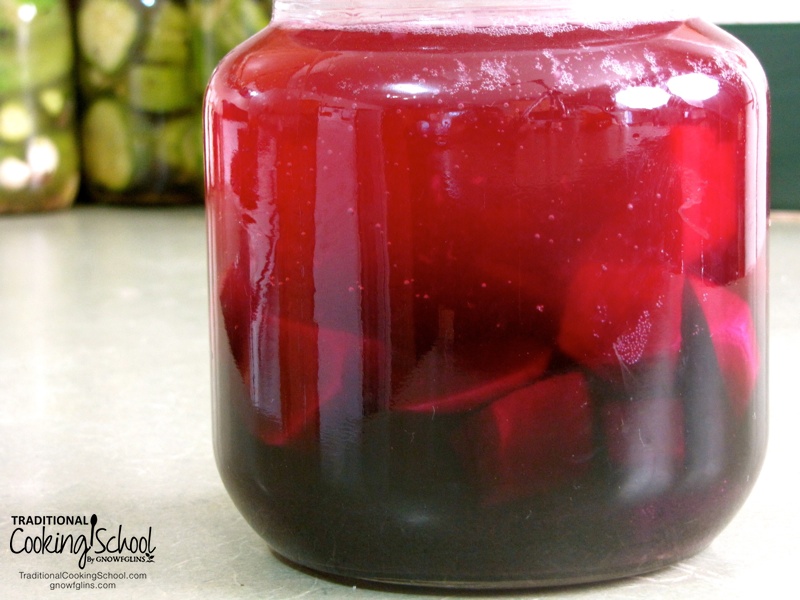
Nourishing Traditions calls beet kvass, a traditional fermented beverage, an “excellent blood tonic” that “promotes regularity, aids digestion, alkalizes the blood, cleanses the liver and is a good treatment for kidney stones and other ailments”.
Beet kvass tastes earthy and salty and rich. Here’s my recipe.
Also, combine with carrots for carrot-beet kvass!
Kanji
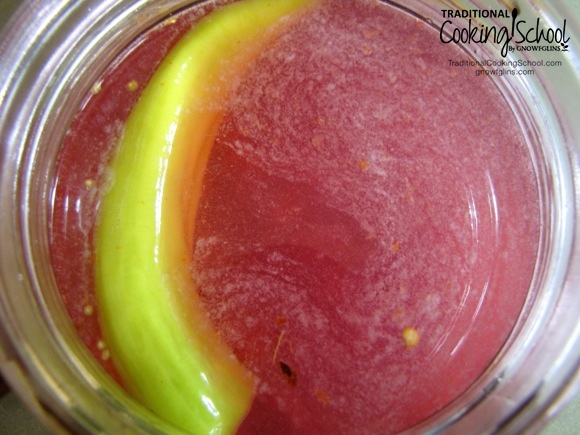
What is kanji? A spicy Indian kvass made from beets (of course), plus carrot, hot pepper, and mustard.
Find my recipe in The Complete Idiot’s Guide to Fermenting Foods, or my Lacto-Fermentation eBook or eCourse.
Roasted Beet and Watermelon Salad from MyHumbleKitchen.com
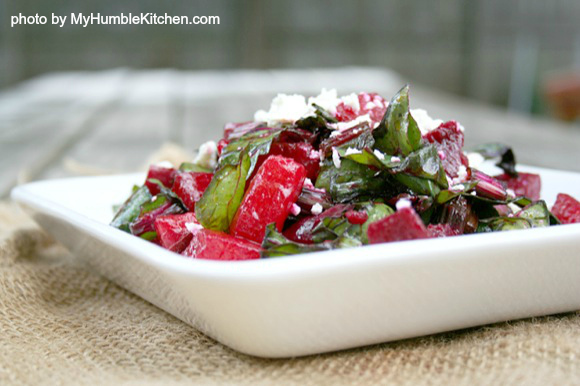
Finally, last week Diana from My Humble Kitchen shared a beautiful Roasted Beet and Watermelon Salad.
Toss roasted beets with watermelon chunks, chopped beet greens, extra virgin olive oil, balsamic vinegar, sea salt, and pepper. Then top with feta cheese. Mmmm… tantalizing! Click here to go to the recipe.
For more delicious ways to use beets, here are 60+ Root Vegetable recipes.
What About The Greens?
They’re edible, nutritious and delicious! Lightly steam them and drain away the water to reduce oxalic acid (more info here). Toss with butter, sea salt, and pepper. Drizzle with lemon juice if desired.
What do you do with beets? Please share your favorite recipes or ideas in the comments!
...without giving up the foods you love or spending all day in the kitchen!

2 free books:
Eat God's Way
Ditch the Standard American Diet, get healthier & happier, and save money on groceries...
We only recommend products and services we wholeheartedly endorse. This post may contain special links through which we earn a small commission if you make a purchase (though your price is the same).


this is perfect…just what I needed! Thank you!
What a great post!! I’ve just started buying beets and so far have only used them for kvass and roasted them with some potatoes once. I’m excited about all the other recipes you’ve listed and will be trying them very soon. Thanks, Wardeh!!
Hi Wardee, I was just regarding a blog post yesterday that shredded best is a no-no, apperantly it also mentioned in the Nourishing Tradition. Here is the blog post:
http://ohlardy.com/fermenting-fail-cause-i-like-to-keep-it-real
Do you have any similar experiences? -Guro
Guro — Yes, I know it is mentioned in Nourishing Traditions under the directions for beet kvass. (Don’t use shredded beets.)
However, my shredded beets turned out fantastic. But I expected that because we’ve had delicious shredded fermented beets from Wise Choice Market. To be on the safe side, one could use a starter culture to promote a lactic acid fermentation. I did not use a starter culture, though, and I fermented a short two days. My experience was nothing like what was shown in that blog post. 🙂
Thanks Wardee 🙂
Just in time. Order 2 cases of beets from Azure Standard. Planned my usual to ferment shredded beets for salad and make beet kvass, but was looking for other alternatives.
Hi Wardee,
Thanks for the beet recipes. I feel so much better when I eat them on a regular basis and I need some new ways to eat them. I was thinking of steaming the greens and dehydrating them to add to my “greens” bag for soups this winter….however, was wondering if you have a creative and yummy idea for the stems? They have so much color in them I assume they are really good for you as well. I wondered if you ever made them into pickles or just diced them into kvass, or do you ditch them? Thanks again, I really enjoy your classes and am looking forward to the new class coming up!
http://www.gourmet.com/recipes/diaryofafoodie/2009/01/pasta-with-beet-greens
This recipe uses both stems and leaves and even my husband liked it.
Eatingwell.com has my favorite borscht recipe, which I canned for the first time (though we haven’t tried it yet).
I used to just toss the stems into the composter but then I started saving them in the refrigerator and add a few each morning to my blender smoothie. I never taste them and I know I’m getting great nutrition! Thanks to posts like this I just started two pints of lacto-fermented beet stems with the brine and some pickling spices. We’ll see…
Finally! A post on fermenting beets … I’ve been looking on several blogs and haven’t found any till now! 🙂 I had loads of beets from the garden this year, pickled most of them the “usual” way and decided to try fermenting several quarts, having read about it in Nourishing Traditions. I used 1 tablespoon of salt per quart of beets (which were cooked enough to slip off the skins), covered them with cheesecloth held with a canning ring and they got moldy on the top. There are little bubbles throughout the brine, although the brine is more like gel – thick and goopy. If I scoop off the moldy part, the beets smell nice – like regular pickled beets. Are they safe to eat? I want to try them so badly but am afraid I’ll get sick! What are the dangers of eating food that hasn’t been fermented properly?
I know I’m replying to a post that is over a year old, but I wouldn’t ferment *cooked* beets with this method! The enzyme activity in raw beets is essential to the fermentation process and the salt helps create an environment where acids will naturally form, preventing spoilage. Salt alone is not enough of a preservative to keep cooked (dead) beets from growing bacteria that could make you very sick.
What do you mean by ‘Burp jar as needed’? do you open to release air? cheers and looking forward to my beets!
Hi Penni,
Yes, open the jar to release the pent up gas. I always burp my jars over the sink after experiencing one to many fizzy jars and messes. 🙂
Help! I’m a fermenting rookie. Some youtube videos and fermenting instructions say not to burp the jars because it will cause mold. Others say if you don’t burp the jars, they will explode. Some say to slightly burp the jars, which I don’t know how to do. Can you please help me. I don’t have fancy jars, just plain mason ones. Thank you!!!!
What I always make with beets:
I wash them, wrap them in aluminium foil and put them in the oven for about 45 minutes (200 degrees Celsius) I let them cool down, peel and chop them in chunks. Add a diced onion, Crème Freche/Sour cream and some ground pepper. This makes a delicious sweet and fresh side dish.
And because the dish is very bright pink in colour, its always a favourite amongst my little nieces.
Sounds tasty, might try this and substitute your beet recipe instead of regular coleslaw.
I love posts like this, because this is how it is when you have a garden. You get a lot of one kind of thing, and you need to figure out how to preserve it, and make it several different ways. I’m not a regular reader, but I am a long time reader, and if you don’t already have posts like this with other garden items, I request more please! 🙂
When we moved to property with an orchard and big garden I started a file drawer of recipes organized by main garden ingredient. Works great, especially in apple season. No recipe is kept that only calls for one apple. LOL!
Turned out delicious!
I just grabbed a jar of the fermented beets from the fridge, they are gooey not crisp. Is this how they are auppose to be? I tried a little but it is really hard to chew and swallow.
I have been fermenting everything from cucumbers ,onions, carrots, beets, cabbage… for many years.
All veggies can be fermented.
But, I don’t seal my jars.
I make sure I cover the veggies with water.
***If anything is not covered it will mold.
Or, use a pickling pebble.
(A glass weight that keeps the veggies from rising above the water)
**Available for wide mouth mission jars.
Side note, Anything heated looses its healthy gut good bacteria. You may as well can with vinegar.
I enjoy them year round. I am lucky to have a second fridge to store all my probiotic fermented canned veggies.
I just sat my lid on top. (Not screwed on… maybe one turn)
I have never had problems with too much gas.
Or have never had to “burp” a jar.
I make it similar to making water kiefer
It Ferments in 3 days.
Love the beet recipes.
What i tend to do with mine, is pretty simple but tasty.
I wash and peel them, then slice them into about 1/2 inch / 1 cm slices, and pan fry them in a little oil and butter until starting to ‘catch’, then i either add a tablespoon of runny honey, or a spoonful of unrefined sugar and allow them to fry a little more. Don’t fry too long after adding the honey / sugar, as this might burn.
They come out not too soft and not too firm, but deliciously sweet and savoury with a little bite. Great served as a side with chicken or beef steak.
Hi, Andy,
Thank you for sharing! Sounds wonderful. 🙂
~Peggy, TCS Customer Success Team